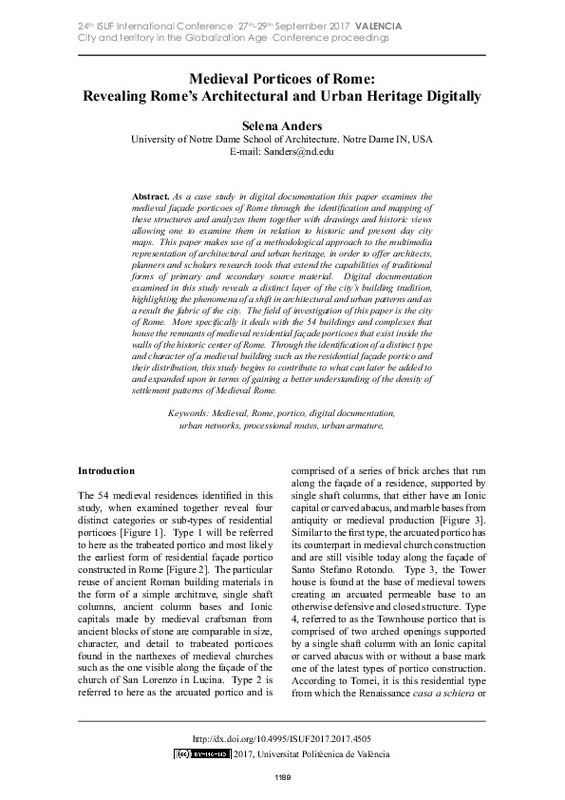JavaScript is disabled for your browser. Some features of this site may not work without it.
Buscar en RiuNet
Listar
Mi cuenta
Estadísticas
Ayuda RiuNet
Admin. UPV
Medieval Porticoes of Rome: New Methods and Technologies for Revealing Rome’s Architectural and Urban Heritage
Mostrar el registro sencillo del ítem
Ficheros en el ítem
| dc.contributor.author | Anders, Selena
|
es_ES |
| dc.coverage.spatial | east=12.496365500000024; north=41.90278349999999; name= Roma, Itàlia | es_ES |
| dc.date.accessioned | 2018-11-14T08:13:01Z | |
| dc.date.available | 2018-11-14T08:13:01Z | |
| dc.date.issued | 2018-04-20 | |
| dc.identifier.isbn | 9788490485743 | |
| dc.identifier.uri | http://hdl.handle.net/10251/112426 | |
| dc.description.abstract | [EN] At the moment there are few comprehensive texts or instruments that allow architects, designers, historians, planners or even students the ability to understand the complex layers of a city’s urban fabric. As a result, this paper was prepared in order to be uploaded to a digital tool that allows for such exploration of the built environment. The transformation of the city of Rome is documented in a number of sources and as a result makes it the ideal city for study of architectural and urban evolution. As a case study in digital documentation this paper examines the medieval façade porticoes of Rome at three scales: urban, architectural, and detail. The identification and mapping of these structures, are shown together allowing one to examine them in relation to historic and present day city maps. In addition, their location is analyzed in relation to ancient Roman streets and historic processional routes, to observe the connection amongst their location and that of major thoroughfares of antiquity, the Middle Ages, and the Renaissance. At the architectural scale, the detailed documentation in plan and elevation reveal four distinct variations that existed in the use of the residential façade portico. At the scale of architectural detail, an inventory of reused architectural elements or spolia that make up the residential porticoes reveal the reuse of ancient Roman column shafts, bases and capitals as well as the medieval masons’ preference for the use of the Ionic capital in particular. This paper prepares a methodology for digital deployment of traditional scholarship focused on architecture and the built environment. | es_ES |
| dc.format.extent | 10 | es_ES |
| dc.language | Inglés | es_ES |
| dc.publisher | Editorial Universitat Politècnica de València | es_ES |
| dc.relation.ispartof | 24th ISUF International Conference. Book of Papers | es_ES |
| dc.rights | Reconocimiento - No comercial - Sin obra derivada (by-nc-nd) | es_ES |
| dc.subject | Medieval | es_ES |
| dc.subject | Rome | es_ES |
| dc.subject | Portico | es_ES |
| dc.subject | Digital documentation | es_ES |
| dc.subject | Urban networks | es_ES |
| dc.subject | Processional routes | es_ES |
| dc.subject | Urban armature | es_ES |
| dc.title | Medieval Porticoes of Rome: New Methods and Technologies for Revealing Rome’s Architectural and Urban Heritage | es_ES |
| dc.type | Capítulo de libro | es_ES |
| dc.type | Comunicación en congreso | es_ES |
| dc.identifier.doi | 10.4995/ISUF2017.2017.4505 | |
| dc.rights.accessRights | Abierto | es_ES |
| dc.description.bibliographicCitation | Anders, S. (2018). Medieval Porticoes of Rome: New Methods and Technologies for Revealing Rome’s Architectural and Urban Heritage. En 24th ISUF International Conference. Book of Papers. Editorial Universitat Politècnica de València. 1189-1198. https://doi.org/10.4995/ISUF2017.2017.4505 | es_ES |
| dc.description.accrualMethod | OCS | es_ES |
| dc.relation.conferencename | 24th ISUF 2017 - City and Territory in the Globalization Age | es_ES |
| dc.relation.conferencedate | Septiembre 27-29,2017 | es_ES |
| dc.relation.conferenceplace | Valencia, Spain | es_ES |
| dc.relation.publisherversion | http://ocs.editorial.upv.es/index.php/ISUF/ISUF2017/paper/view/4505 | es_ES |
| dc.description.upvformatpinicio | 1189 | es_ES |
| dc.description.upvformatpfin | 1198 | es_ES |
| dc.type.version | info:eu-repo/semantics/publishedVersion | es_ES |
| dc.relation.pasarela | OCS\4505 | es_ES |








